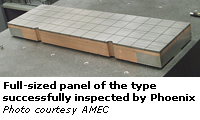Phoenix inspects first wall panel for fusion reactor
18/06/2008
 A technique for testing wall panels for one of the world's first nuclear fusion reactors has been developed by Phoenix Inspection Systems.
A technique for testing wall panels for one of the world's first nuclear fusion reactors has been developed by Phoenix Inspection Systems.Phoenix has successfully inspected the first full-sized panel designed for use in the International Thermonuclear Experimental Reactor (ITER). The panel, which consists of copper alloy and stainless steel, clad with beryllium tiles, was manufactured by AMEC using an innovative hot isostatic pressing (HIP) process. It is designed to withstand the high temperatures and radiation flux cycling within the reactor.
AMEC has spent a decade developing the HIP process, starting with a 100 x 100 mm panel weighing less than 5 kg. Its latest project has involved scaling up the process to produce a full-sized panel measuring 250 mm x 900 mm x 90 mm and weighing over 80 kg. Phoenix has been working with AMEC since the early days of the project to develop inspection procedures for the panels.
Karl Quirk, Managing Director of Phoenix, explained the process: "The panels contain two different types of bonds – between beryllium and copper, and copper and stainless steel. The problem for inspection is that where bonds occur between two different metals, there is a significant indication from a good bond.
"The inspection process seeks to find signals in the region of the joint that are above what you would expect from a well-bonded interface along with other indications of weakness, such as areas of low amplitude over corners or edges where localised strain is likely to occur.
"We have been using immersion testing for the reliability of coupling it offers between the transducer and the inspection surface and the capability for complete coverage and scanning of the joint. Above all, it allows focused high-frequency ultrasound to be used which maximises the prospect of finding small defects. However, the inspection must be carried out in oil due to the hazard of beryllium reacting with water."
Eric Rodgers, AMEC project manager, said: "This latest project is the culmination of a decade's work for us. We have been working with Phoenix for most of that time due to their expertise in overcoming complex inspection problems and developing novel tools and techniques."
The panel will now be tested at the JUDITH facility at FZJ in Germany using an electron beam scanned rapidly over the surface to produce 30,000 cycles of heating and cooling at a power level of 0.5 MW/m2 to replicate the conditions expected in ITER.
ITER brings together Europe, Japan, China, India, South Korea, the Russian Federation and the USA in a joint international research and development project that aims to demonstrate the feasibility of fusion power. ITER will be constructed at Cadarache in the South of France.
For further information contact Paul Ryan on 01925 826000.